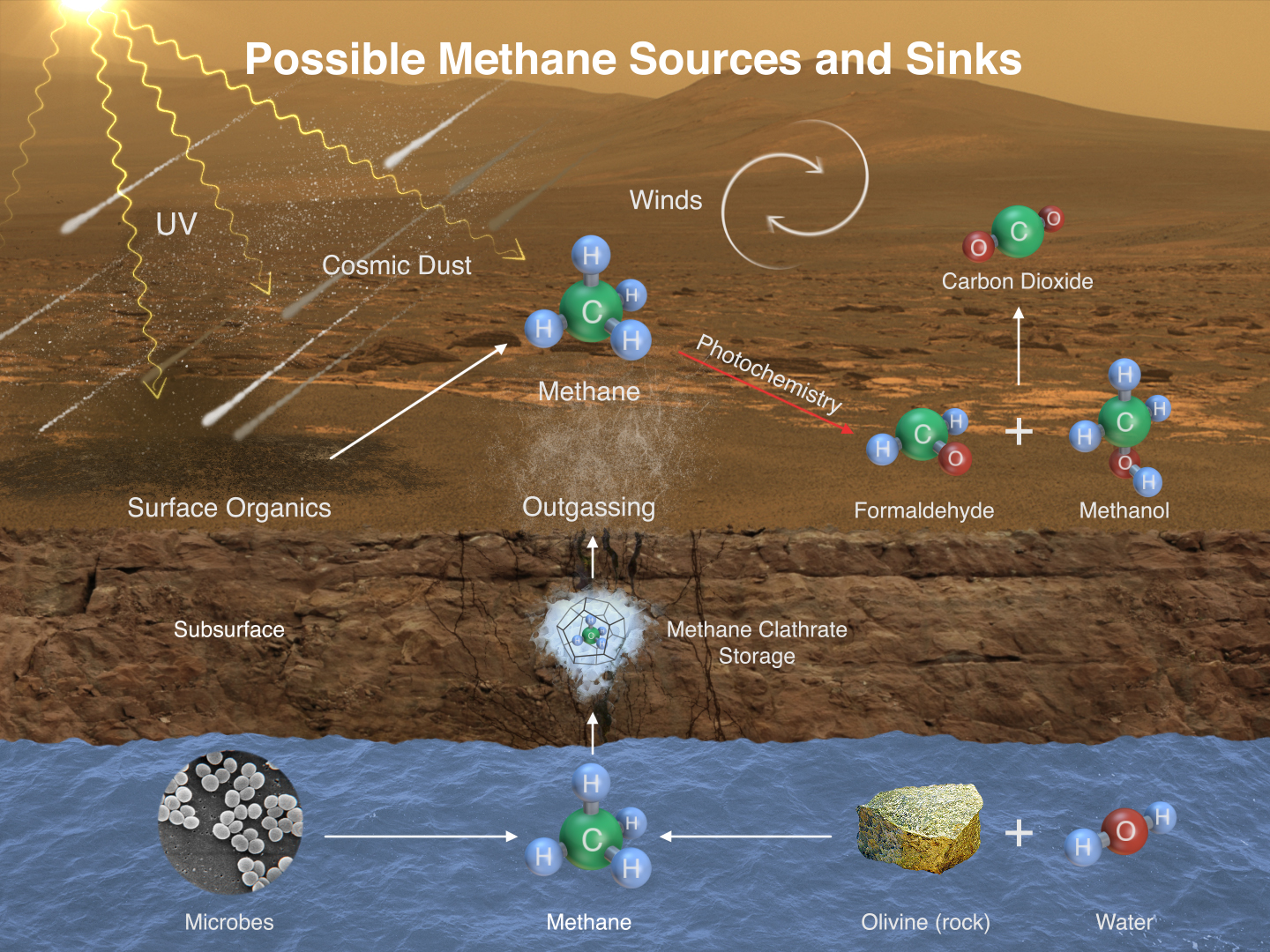
NASA’s Curiosity rover has made a double dose of exciting discoveries on Mars by detecting a short-term, tenfold spike in atmospheric methane, the simplest organic compound, and also making the first definitive detection of a more complex organic molecule in a rock-powder sample gathered by the robot’s high-speed drill at Gale Crater.
Overall, these new and “hard won” results have the potential to increase the chances that Mars had the right set of habitable conditions to “spawn life” at some time, but much more data and careful analysis is required to answer the life question in any definitive way.
Although organic molecules are the chemical building blocks of life, they can also easily exist without the presence of life and have an abiological origin, such as from deposition by meteorites.
Scientists leading NASA’s Curiosity Mars Science Laboratory (MSL) rover mission announced the findings of methane and organics on Tuesday, Dec. 16, at a media briefing held at the annual meeting of the American Geophysical Union (AGU) in San Francisco, Calif.
“We now have full confidence that methane (CH4) is occasionally present in the atmosphere of Mars and that there are organics preserved in ancient rocks on Mars in certain places,” said Dr. John Grotzinger, Curiosity project scientist of the California Institute of Technology in Pasadena (Caltech), at the briefing.
“Both these discoveries are consistent with the former presence of life or existing presence of life. So detecting methane .. and large organic molecules … is not an argument that we have found evidence of ancient life on Mars.”
“These detections are not proof of life on Mars, but it’s one of the few hypothesis we must consider as we go forward in the future.”
“But organics of any kind, even abiotically produced organics, are the kinds of material we need to look for if we are ever going to find evidence that microbes once existed on Mars.”
“This is really exciting news and we have scientific publications coming out today in Science magazine about methane and another paper is in review about the organics.”
“These results are ‘hard won’ and it took a long time to understand where to drill rocks and where to go. And during the long trek from Yellowknife Bay we were continuously analyzing these samples over and over again. Curiosity is a laboratory and that’s why it takes a long time to get to these conclusions,” Grotzinger explained.
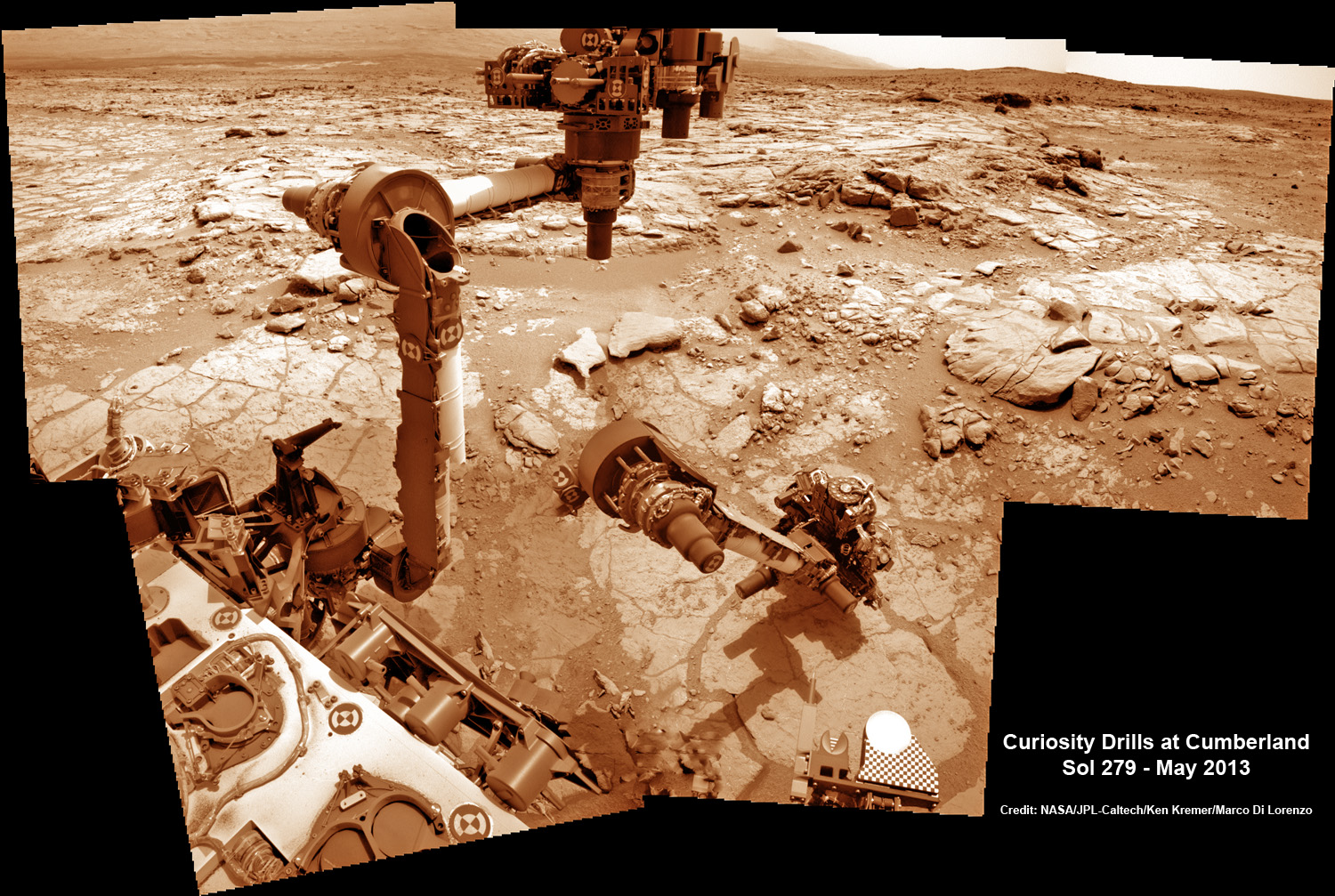
Curiosity detected several brief spikes in the atmospheric methane (CH4) level using the onboard Sample Analysis at Mars (SAM) laboratory during a total of a dozen measurements over a 20-month period.
Methane levels averaging seven parts per billion by volume were found during multiple analyses conducted in late 2013 and early 2014. In all other measurements before and after, Curiosity determined that the background level of methane was only about 0. 7 parts per billion by volume (ppbv), or one-tenth of the temporary spiked quantity.
“This temporary increase in methane — sharply up and then back down — tells us there must be some relatively localized source,” said Sushil Atreya of the University of Michigan, Ann Arbor, and Curiosity rover science team.
“There are many possible sources, biological or non-biological, such as interaction of water and rock.”
The amazing new science findings come more than two years after Curiosity safely touched down on Mars beside humongous Mount Sharp, which towers 3.4 miles (5.5 kilometers) into the Martian sky, inside Gale Crater which is 96 miles (154 kilometers) in diameter.
“Since landing on Mars 2.5 years ago, Curiosity has made an amazing array of fabulous discoveries that have completely changed our thinking about early Mars,” said Dr. Jim Green, NASA’s Director of Planetary Sciences at NASA Headquarters, Washington, D.C., at the briefing.
“When life started on Earth, Mars had a significant atmosphere and water resources. If Gale Crater is any indication Mars could have had many places that spawned life and survived in a habitable region.”
The methane measurements were made using the Tunable Laser Spectrometer (TLS) instrument in the rover’s SAM laboratory suite.
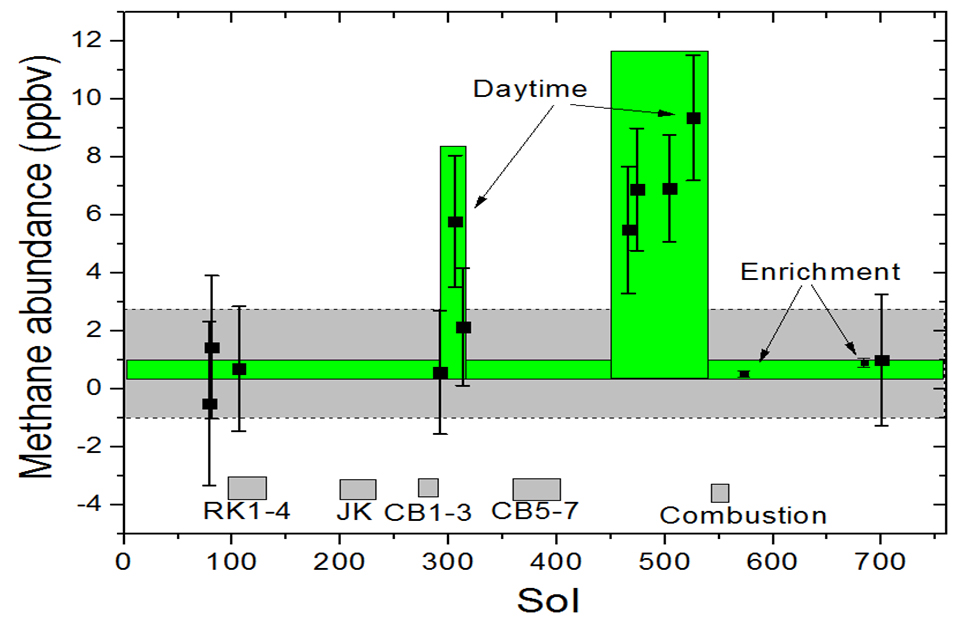
“These are the first ‘in situ’ measurement of methane in the Martian atmosphere,” said Christopher Webster, NASA Curiosity Science Team Co-investigator, NASA Jet Propulsion Laboratory, Pasadena, Calif., at the briefing. “It looks at three distinct lines that can only be methane. So we are very confident.”
“We report detection of background levels of atmospheric methane of mean value 0.69 ppbv. Additionally in four sequential measurements spanning a 60-sol period, we observed elevated levels of methane of 7.2 ppbv implying that Mars is episodically producing methane from an additional unknown source.”
“This lasted for about two months and after that we were back to background levels. So we witnessed an unexpected, episodic increase in methane.”
The methane background level of 0.7 ppbv represents about 5,000 metric tons in Mars atmosphere, said Grotzinger.
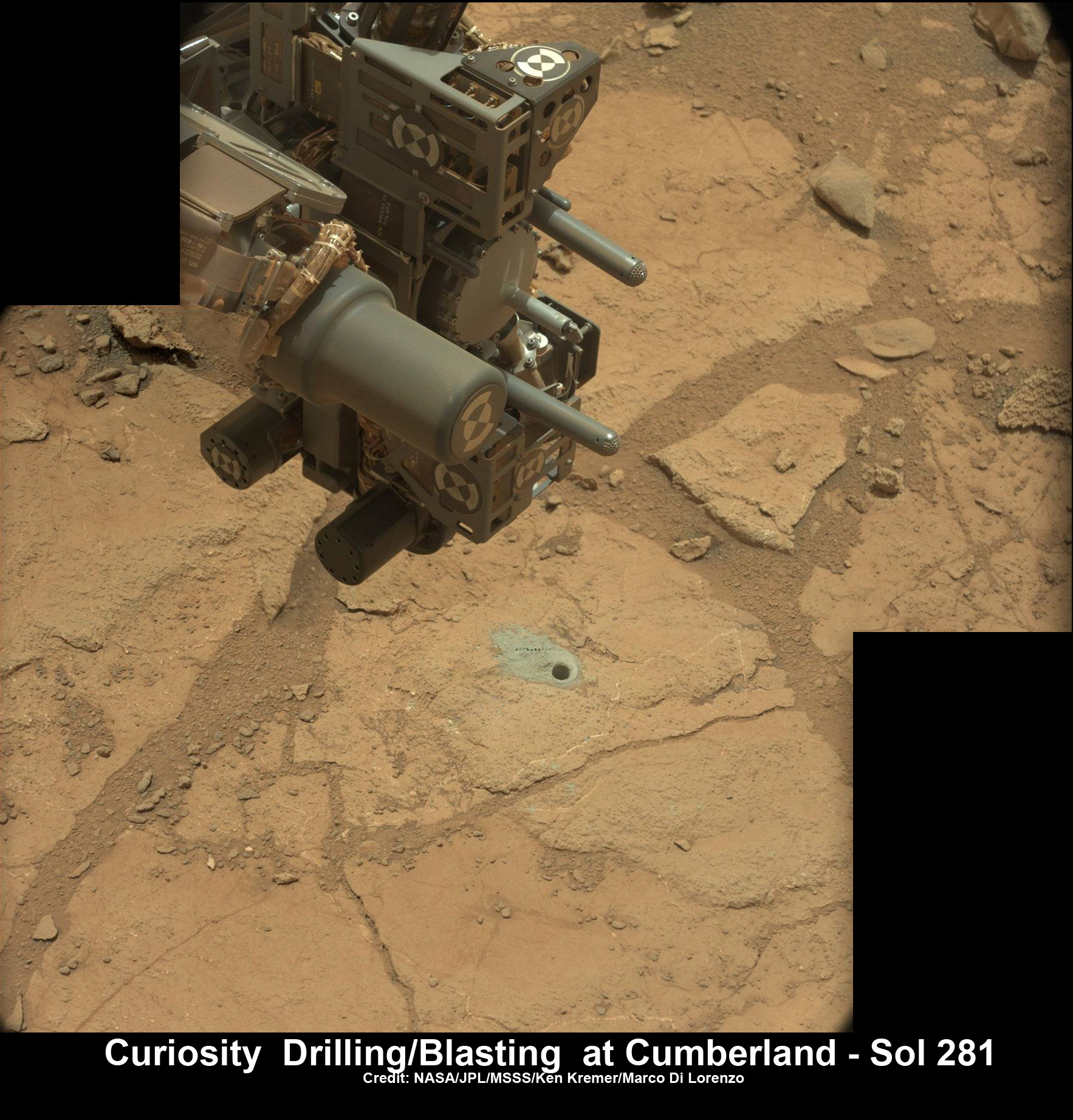
There are several possibilities for the source of the methane that include generation both by microbes and non-biological processes such as reactions between water and olivine (or pyroxene) rock.
Atreya said the sources included ultraviolet radiation (UV) induced reactions that generate methane from other organic chemicals on the surface produced by either biological or non-biological processes, such as comet dust falling on Mars. Another possibility is methane generated underground in the past might be stored within lattice-structured methane hydrates called clathrates, being released by the clathrates into the atmosphere today.
The detection of organics in the rock samples also involved using the Curiosity SAM lab located in the belly of the six-wheeled rover.
The rover has delivered four soil and rock samples to SAM thus far and continued to reanalyze them during the long drive to Mount Sharp. The researchers are seeking to determine whether any significant levels of organics could be detected by SAM and whether they were transported from Earth as contaminants or were truly Martian in origin.
After extensive analysis, the team is now confident that the organics detected in the “Cumberland” rock-powder drill sample from Yellowknife Bay are indeed Martian organics.
Specifically, the team detected an aromatic six carbon molecule called chlorobenzene (C6H5Cl) in the Cumberland sample.
The amount of chlorobenzene detected in Cumberland was much higher compared to three other samples analyzed in the “Rocknest” soil sample.
See the graphic herein comparing the amounts detected on a vertical scale of picomoles as measured with SAM’s gas chromatograph mass spectrometer system (GCMS).
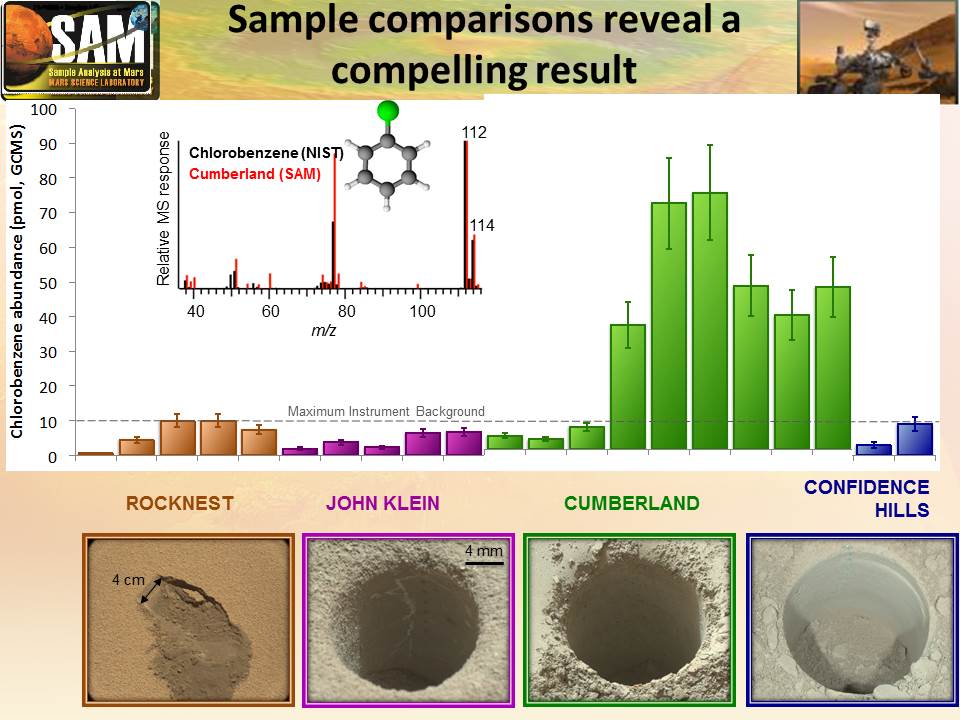
The Cumberland sample was cored in spring 2013, following a few months after the first interplanetary drill sample—dubbed “John Klein.” They were both gathered from the ancient lake bed area named Yellowknife Bay and located about two meters apart, Grotzinger explained.
“This first confirmation of organic carbon in a rock on Mars holds much promise,” said Curiosity participating scientist Roger Summons of the Massachusetts Institute of Technology in Cambridge.
“Organics are important because they can tell us about the chemical pathways by which they were formed and preserved. In turn, this is informative about Earth-Mars differences and whether or not particular environments represented by Gale Crater sedimentary rocks were more or less favorable for accumulation of organic materials. The challenge now is to find other rocks on Mount Sharp that might have different and more extensive inventories of organic compounds.”
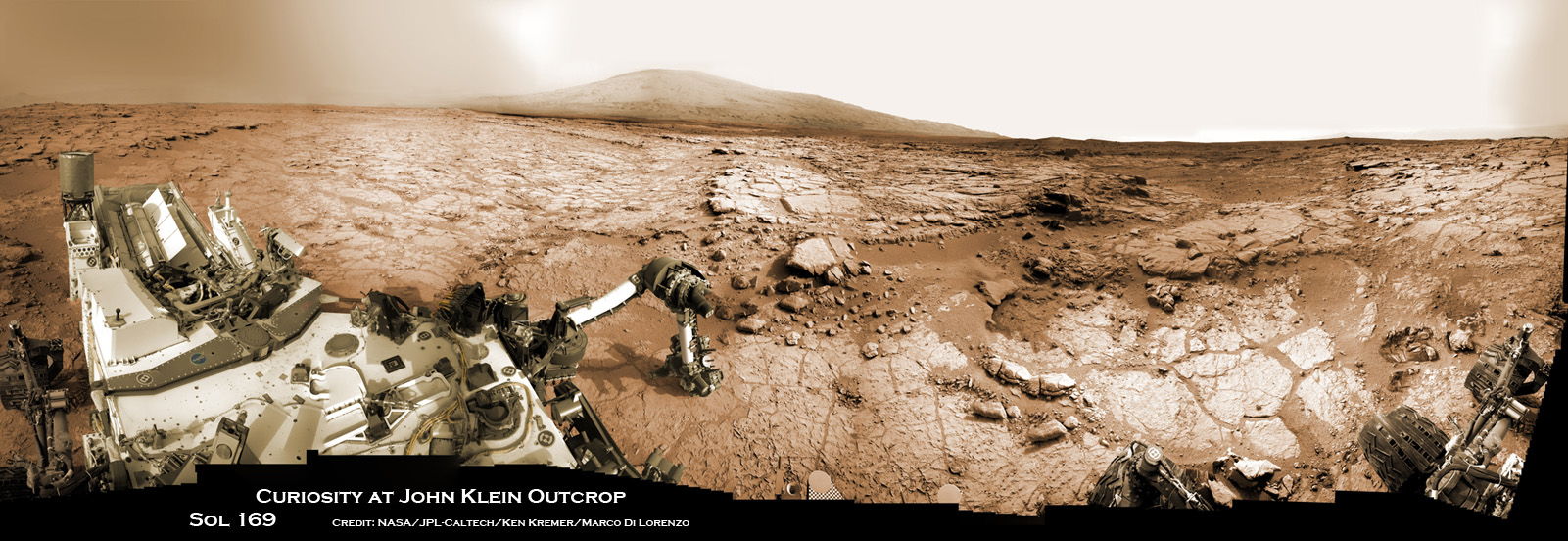
What is the source of chlorobenzene?
It may have been produced on heating the pulverized sample inside SAM upon the reaction of Martian organic chemicals such as benzoic acid (C6H5COOH) with a strong oxidizer such as a Martian perchlorate present in the soil and rocks. Therefore, the original precursor chemicals actually present in the Martian samples have yet to be determined.
Numerous lab experiments are in progress back on Earth to try and replicate the formation of chlorobenzene in the SAM ovens. The experiments will take quite some time to complete and require careful scrutiny and analysis, said Summons.
In the meantime, Grotzinger said Curiosity will likely be directed to drill one or more samples near her current location, after the Christmas holidays, to scope out the area and more fully characterize the chemical and geological environment to provide a baseline before moving on and up Mount Sharp.
Exciting times lie ahead, especially in light of the another recently announced Curiosity discovery that Gale Crater once harbored a giant lake filled with liquid water for tens of millions of years and further enhances the chances that life may have gained a foothold on ancient Mars when it was warmer and wetter billions of years ago.
So far Curiosity’s odometer totals over 5.5 miles (9.0 kilometers) since landing inside Gale Crater on Mars in August 2012. She has taken some 205,000 images during over 820 Sols of exploration.
Stay tuned here for continuing updates.

Want to keep up-to-date with all things space? Be sure to “Like” AmericaSpace on Facebook and follow us on Twitter: @AmericaSpace




This is indeed exciting news. Between the color images of Saturn’s moons and the discoveries on Mars, it points to a rich source of information about possible habitable conditions right in our own “back yard.” I continue to support and urge exploration that will enhance our understanding of habitable planets in distant galaxies.
Ken – both you and Leonidas are providing invaluable information to your readers and, hopefully, igniting interest in a younger generation of scientists, engineers and dreamers in planetary exploration.
Thank you!